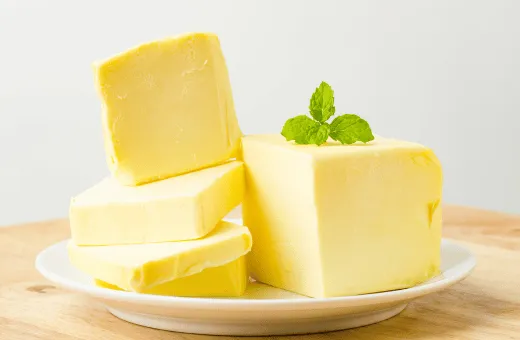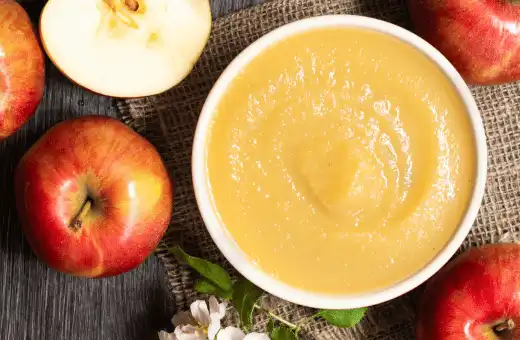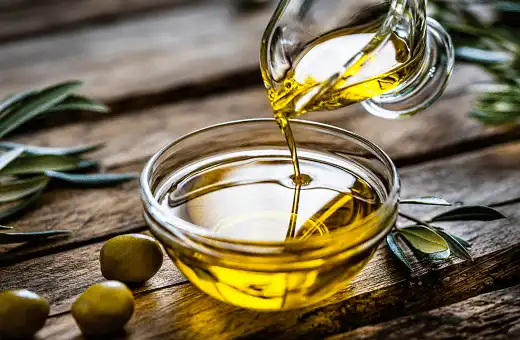As a home cook or chef, you know that vegetable shortening is an essential ingredient in many recipes.
From desserts to pies and pastries, it’s often used to create light and flaky crusts.
But what do you do when you run out of vegetable shortening or you’re looking for a healthier alternative?
Don’t worry; I’ve got you covered! In this post, I’ll share with you 9 ideal substitutes for vegetable shortening, with ratios and how to use these alternatives in your cooking.
In short, " What can I use instead of vegetable shortening?" Butter, Coconut Oil, Lard, Margarine, Shortening Powder, Applesauce, Greek Yogurt, Soy Margarine, Olive Oil.
What is vegetable shortening, and what does vegetable shortening taste like?
Vegetable shortening is a type of fat utilized in baking and cooking that is made from vegetable oils such as soybean, palm, or cottonseed oil.
It has a neutral flavor and is often used to produce light-colored baked goods with a fluffy texture.
Vegetable shortening does not have much of a taste, but it gives baked goods an incredibly rich and tender texture.
When melted, the shortening produces an unmistakable greasy smell.
Uses of vegetable shortening
Vegetable shortening is a type of fat utilized in cooking and baking.
It is typically made from partially hydrogenated vegetable oil and has a creamy texture and a high smoke point, making it the ideal fat for frying, sautéing, and baking.
When used in baking, shortening helps to create flaky, tender pastries or crusts by creating air pockets that are sealed off during the heating process.
In addition to being used in cooking or baking, vegetable shortening can also be used as a spread or topping for toast and other baked goods.
It provides much-needed moisture, which helps to prevent food like bread from becoming dry or stale.
Vegetable shortening is also often combined with other ingredients to make delicious sauces such as Hollandaise or Béarnaise sauce.
Vegetable shortening is also an ideal choice when grilling meats since it will not burn easily due to its high smoke point.
This makes it less likely for food to become charred on the outside while still being uncooked on the inside.
Furthermore, because of its creamy texture, it can be used to coat vegetables before grilling as a way to add flavor while keeping them moist during the cooking process.
Where to buy vegetable shortening?
If you are looking for where to buy vegetable shortening, there are a few different places you can go. Many specialty food stores carry it, as do some international grocery stores.
You can also order online from many retailers that provide a variety of diverse flavors and types of vegetable shortening.
Best substitutes for vegetable shortening
1. Butter – a good substitute for vegetable shortening

The first vegetable shortening substitute on our list is butter. Butter is a great alternative because it’s widely available, has a rich flavor, and is easy to use.
Ratio or measurement: Use a 1:1 ratio when replacing vegetable shortening with butter, but bear in mind that butter has a lower melting point.
So use less of it than you would have with vegetable shortening.
Discover more: Best Golden ray butter substitutes
2. Coconut Oil – gives you a similar taste to vegetable shortening
Coconut oil is a versatile substitute that not only works great in baked goods but it’s also excellent for cooking and frying.
Ratio or measurement: Use a 1:1 ratio of coconut oil to vegetable shortening, but be sure to melt it before using it in your recipe.
3. Try Lard in place of vegetable shortening

While lard may not be a popular ingredient, it makes an excellent substitute for vegetable shortening.
Ratio or measurement: Because its melting point is similar to that of vegetable shortening, it's best to utilize a 1:1 ratio when substituting it for vegetable shortening.
4. Margarine – gives you a similar taste to vegetable shortening
Margarine is a mixture of oils and water that makes it an ideal substitute for vegetable shortening.
Ratio or measurement: Use a 1:1 ratio when substituting it for vegetable shortening, but ensure to select margarine with the highest amount of fat content possible.
5. Shortening Powder – a great alternative for vegetable shortening
If you don’t have vegetable shortening or any other substitute mentioned above, shortening powder is a perfect last-minute alternative.
It’s a powdered form of regular vegetable shortening, and you can easily rehydrate it by mixing it with water.
Ratio or measurement: Use 1/2 cup of shortening powder with 1/4 cup of water to replace one cup of vegetable shortening.
6. Applesauce – gives you a similar taste to vegetable shortening

Applesauce is an excellent substitute for vegetable shortening, mostly when making baked goods like cakes that don’t need the shortening to be solid.
Ratio or measurement: Use a 1:1 ratio when replacing vegetable shortening with applesauce. Ensure to use unsweetened applesauce.
7. Use Greek Yogurt instead of vegetable shortening
Lastly, greek yogurt is an excellent replacement for vegetable shortening when making muffins, quick bread, pancakes, and cakes.
Ratio or measurement: Use a 1:1 ratio when substituting Greek yogurt for vegetable shortening; it will give an added tangy flavor and rich texture.
8. Soy Margarine – An ideal substitute for vegetable shortening
Soy margarine is a vegan substitute for vegetable shortening, and it’s a healthier option for those who are health-conscious.
Since it contains no animal products, it’s perfect for vegans, and it can be used in the same ratio as vegetable shortening.
Ratio or measurement: For every 1 cup of vegetable shortening, substitute it with 1 cup of soy margarine.
9. Olive Oil – gives you a similar taste to vegetable shortening

Olive oil is a healthy option for vegetable shortening, and it’s used widely in Mediterranean cooking.
It’s perfect for savory dishes and adds a fruity flavor to your desserts.
Ratio or measurement: For every 1 cup of vegetable shortening, substitute it with ¾ cup of olive oil.
Tips on How to Choose the Most Suitable substitution Option for vegetable shortening
When selecting a suitable substitution for vegetable shortening, consider the following tips:
1. Fat content: Vegetable shortening is 100% fat, so look for substitutes with similar fat content.
Butter, margarine, or coconut oil can be used as alternatives, but keep in mind that they have different moisture levels. Adjustments may be needed in the recipe to account for this.
2. Texture and consistency: Consider the texture and consistency that vegetable shortening provides in your recipe.
If you’re using it for baking, you’ll want a substitute that can achieve a similar level of tenderness and flakiness. Butter or margarine can be good options for this.
3. Flavor profile: Vegetable shortening is relatively neutral in flavor, so choose a substitute that won’t overpower the other ingredients.
Butter adds a rich and slightly savory flavor, while coconut oil can lend a subtle coconut taste.
If you prefer a flavorless substitute, look for shortening alternatives specifically designed for baking.
4. Melting point: Vegetable shortening has a higher melting point than butter, which makes it useful in certain baking applications.
If your recipe requires a solid fat that maintains its structure at room temperature, choose a substitute with a similar melting point.
5. Allergies and dietary preferences: Consider any allergies or dietary restrictions. If you’re looking for a vegan or dairy-free alternative, coconut oil or non-hydrogenated vegetable margarine can work well.
Substitute for vegetable shortening in pie crust
When baking pies, vegetable shortening can be substituted with coconut oil, butter, lard or other plant-based fats.
Coconut oil is a popular alternative because it is affordable, widely available and imparts a subtle sweetness and floral aroma to the crust.
When substituting for vegetable shortening in pie crust, it’s important to remember that coconut oil will change the texture of the crust; it won’t be as flaky as when using vegetable shortening.
To compensate for this difference in texture, it’s best to add 1/4 teaspoon of salt to the dough for every 1/4 cup (60 ml) of coconut oil used.
Additionally, if you’re substituting for butter or lard in your recipe, consider reducing the liquid in your recipe by 2 tablespoons (30 ml) per every 1/2 cup (120 ml) of fat replaced.
Doing so will help keep your crust tender and flaky.
Substitute for vegetable shortening in cake
Vegetable shortening can be easily substituted with butter, margarine or other vegetable or nut oils in cakes.
Butter and margarine lend a more substantial flavor and texture to the cake, while vegetable oils such as safflower, sunflower, and canola oil offer lighter textures that stay moist for a longer period of time.
When substituting for vegetable shortening in a cake recipe, it is important to consider the amount of fat being used since different fats have different levels of fat content.
Depending on the recipe, you may need to adjust either the amount or type of fat used.
Additionally, when substituting vegetable oil for shortening, it is recommended that you use an equal amount as per the recipe to ensure that your cake will still have optimal texture and flavor.
Vegetable shortening substitutes in frosting
There are many other ingredients that can be used as substitutes for vegetable shortening in frosting recipes.
One of the most popular substitutes for vegetable shortening is butter. Butter can add flavor to your frostings while also providing a light and airy texture that’s similar to what you get from vegetable shortening.
However, it should be noted that butter may melt faster than vegetable shortening when applied at room temperature, so it’s best used in recipes meant for refrigerated or frozen desserts.
Another substitute is cream cheese, which gives frosting an even lighter texture while adding a tangy flavor.
Cream cheese also requires refrigeration to maintain its texture, but it has the benefit of being much easier to incorporate into recipes than butter or vegetable shortening.
If you’d like to get creative with your frostings, you can also experiment with margarine or plant-based substitutes for butter and vegetable shortening.
These alternatives are often lower in saturated fat and cholesterol, so they make great options for those looking for healthier options.
Additionally, some margarine and plant-based spreadable products may already have added flavoring agents, such as herbs and spices, that could give your dessert a unique twist.
Substitute for vegetable shortening in fondant
When using fondant, vegetable oil can be used as a substitute for vegetable shortening. Vegetable oils are derived from plants and have a neutral flavor, making them a great option for baking.
Vegetable oil adds moisture to the fondant and can help it hold its shape better, so it’s ideal for covering large cakes or making intricate decorations.
When substituting vegetable oil for shortening, use equal parts of oil for every cup of shortening called for in the recipe.
It’s also important to note that when using vegetable oil instead of shortening, the texture of the fondant may be slightly softer and more pliable than if you had used shortening.
alternatives to vegetable shortening in baking
Vegetable shortening is a great option when it comes to baking, as it helps to create a light, flaky texture in baked goods. However, there are alternatives that can be substituted in its place.
One popular alternative is butter. Butter has more flavor than shortening, and it creates a rich and flavorful crust that can’t be achieved with vegetable shortening.
The downside of using butter is that the texture of baked goods could be slightly harder or less tender than if you used vegetable shortening.
Another option is lard, which can also produce a light, flaky texture when baking.
Lard is more flavorful than shortening and has a higher fat content, which gives the dough more structure and results in a crispier crust.
It also adds moisture to the dough, which helps to make it softer and airier on the inside when baked.
The drawback of using lard is that it may not be suitable for those who follow certain dietary restrictions such as veganism or kosher diets.
For those looking for an animal-friendly alternative to vegetable shortening, coconut oil can be used as well.
Coconut oil imparts a subtle sweetness to baked goods while maintaining the same light and flaky texture that vegetable shortening provides.
It’s also high in healthy saturated fats, which makes it an excellent choice for health-conscious bakers.
However, because coconut oil has a low smoke point compared to other oils, keep an eye on your oven temperature so your baked goods don’t burn easily!
Substitute for vegetable shortening in melting chocolate
When melting chocolate, a suitable substitute for vegetable shortening is coconut oil.
Coconut oil has a high smoking point and is solid at room temperature, which helps reduce the risk of scorching the chocolate.
Additionally, coconut oil imparts a subtle nutty flavor to the melted chocolate. When substituting with coconut oil, use 1 tablespoon per 6 ounces of chocolate.
Unlike vegetable shortening, coconut oil should be melted before combining it with the chocolate.
To melt, heat in short intervals of 5-10 seconds in the microwave until fully liquid.
Substitute for vegetable shortening in biscuits
Vegetable shortening can be replaced in biscuits with a variety of options such as butter, olive oil, coconut oil, or even Greek yogurt.
Butter is an easy substitution and often yields fluffy, flaky biscuits. Olive oil is another great choice for a healthier alternative; it adds subtle flavor and helps keep the biscuits moist.
Coconut oil has an intense flavor that can add a unique twist to your biscuits. Greek yogurt can provide moisture and richness in the biscuit dough while still being relatively low in fat.
Whichever option you choose, make sure to adjust the liquid ingredients accordingly since fats tend to absorb more than other ingredients.
Conclusion on substitute for vegetable shortening
In conclusion, when cooking or baking, it’s essential to know the proper substitutes for the ingredient you may be missing or avoiding for health reasons.
That’s why in this blog post, I wanted to share the 9 ideal substitutes for vegetable shortening in your recipes, along with the ratios and how to use them.
From butter to yogurt, you can confidently substitute vegetable shortening in your baking endeavors.
Don’t be afraid to experiment to find the perfect vegetable-shortening substitute for your recipe. Happy baking!
FAQs on substitute for vegetable shortening
Q1. What is similar to vegetable shortening?
Vegetable shortening is similar to butter, margarine, lard and other animal fats. It is a type of fat made from vegetable oils like soybean, cottonseed, or palm oil.
Vegetable shortening can be used for baking, frying and other cooking purposes and has a high melting point that makes it suitable for deep-frying and pastry doughs.
Additionally, it does not contain any trans fats like some margarine do, which makes it healthier than animal fats.
Q2. What can I use instead of Crisco vegetable shortening?
Instead of Crisco vegetable shortening, you could use an alternative such as butter, lard, coconut oil, olive oil, or a variety of other plant-based oils for baking or cooking.
Butter is perhaps the most common substitute for vegetable shortening and can provide a similar texture to recipes like cakes and cookies.
Lard is another traditional option that can give baked goods a flaky crust.
Coconut oil has become increasingly famous due to its health benefits, and it can also be used in place of vegetable shortening since it has a similar consistency when melted.
Alternatively, if you are looking for a plant-based option, olive oil can be used in some recipes as well.
It’s important to note that when using any of these more natural alternatives to vegetable shortening, they may slightly change the flavor and texture of your recipe, so make sure to experiment with different ones until you find one that works best for your dish!
Instead of Crisco vegetable shortening, you could use an alternative such as butter, lard, coconut oil, olive oil, or a variety of other plant-based oils for baking or cooking.
Butter is perhaps the most common substitute for vegetable shortening and can provide a similar texture to recipes like cakes and cookies.
Lard is another traditional option that can give baked goods a flaky crust.
Coconut oil has become increasingly famous due to its health benefits, and it can also be used in place of vegetable shortening since it has a similar consistency when melted.
Alternatively, if you are looking for a plant-based option, olive oil can be used in some recipes as well.
It’s important to note that when using any of these more natural alternatives to vegetable shortening, they may slightly change the flavor and texture of your recipe, so make sure to experiment with different ones until you find one that works best for your dish!
Q3. What is vegetable shortening? Is it the same as vegetable oil?
Vegetable shortening is solid fat created from vegetable oils, such as soybean or cottonseed oil.
It has a more elevated saturated fat content than vegetable oil, which means it has a longer shelf-life and will remain solid at room temperature.
Vegetable shortening can often be used as an alternative to butter in baking recipes, as it helps to make a light and flaky texture.
While it does have some health benefits over butter, such as lower levels of cholesterol and saturated fat, there are still concerns about its high trans fat content.
So while vegetable shortening may be slightly better for you than butter, it is not the same as vegetable oil.
Vegetable oil is generally much lower in saturated fats than shortening, so it is considered a healthier option for cooking.


